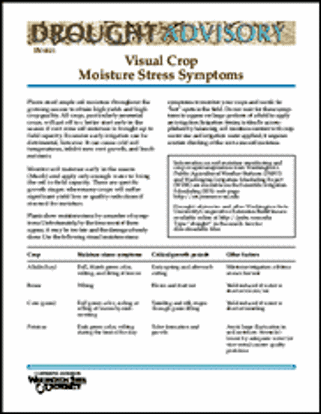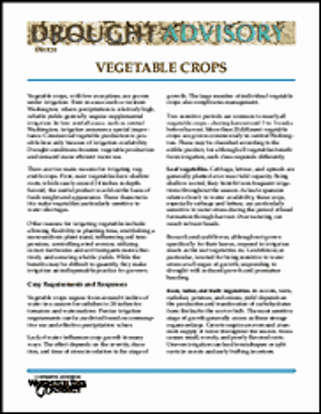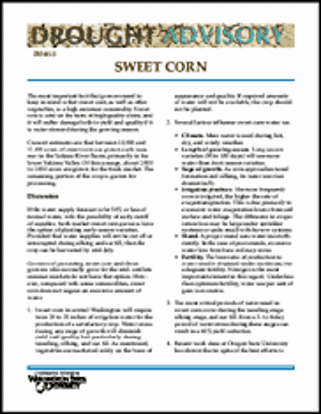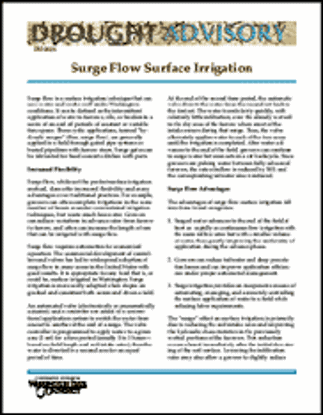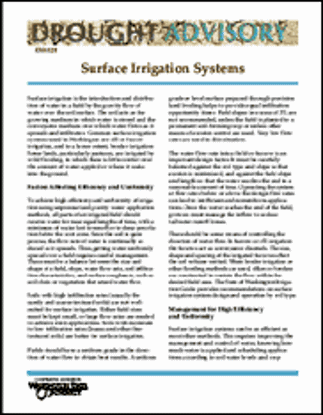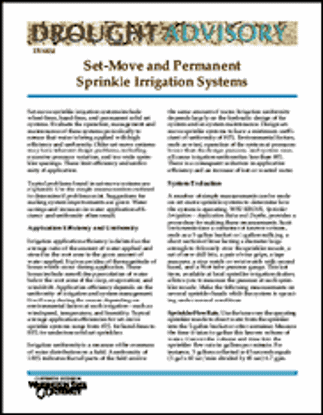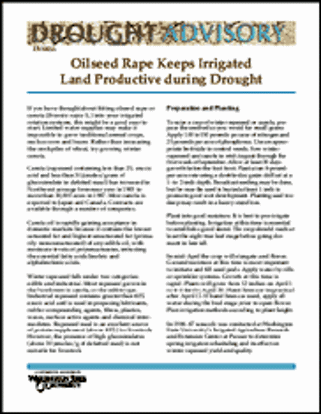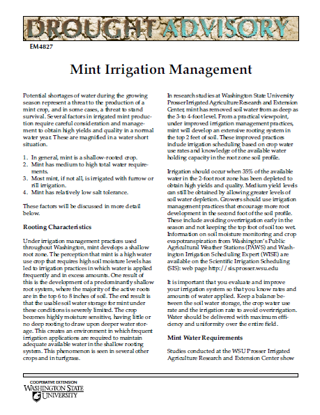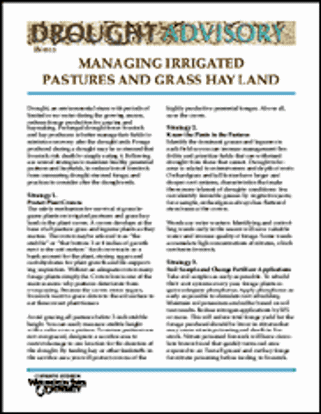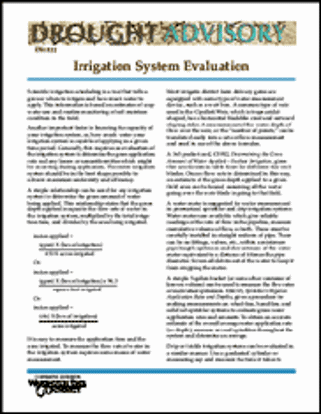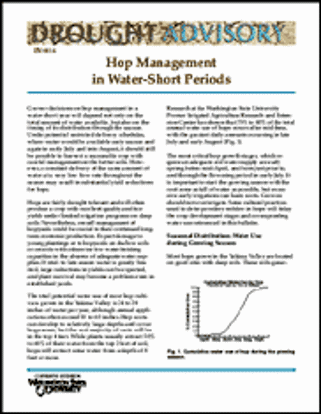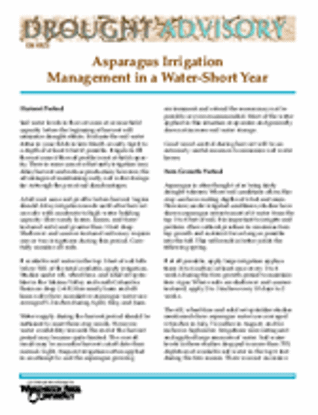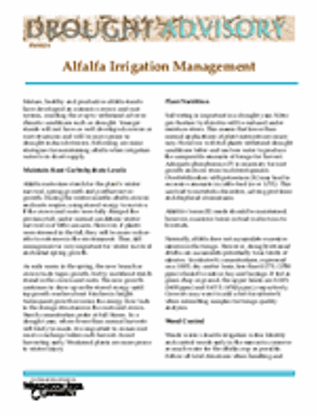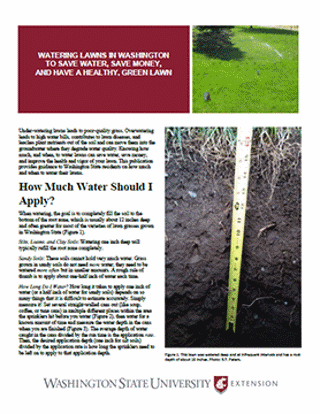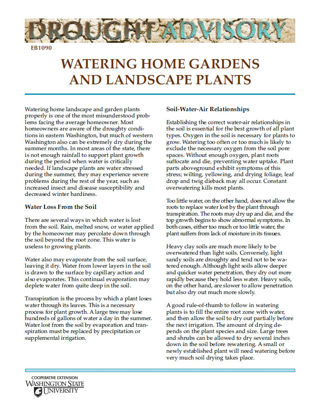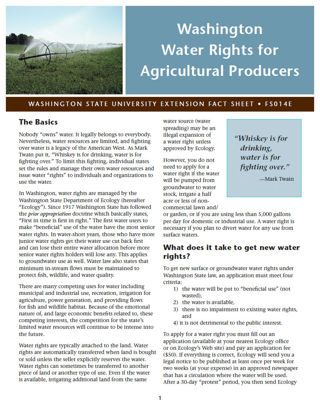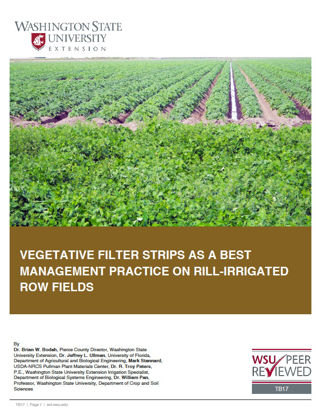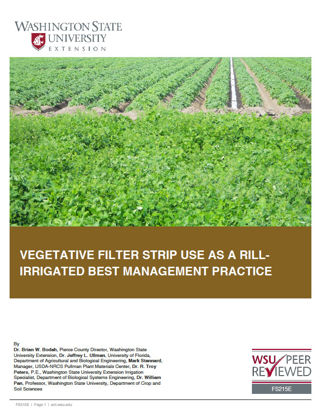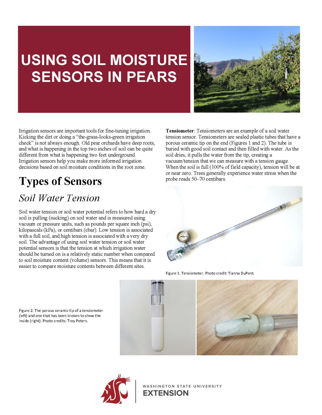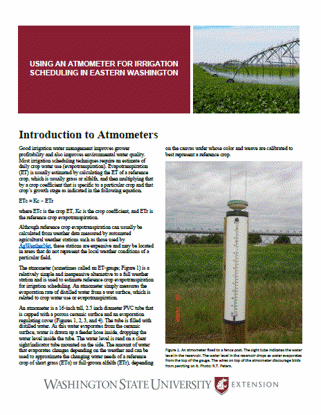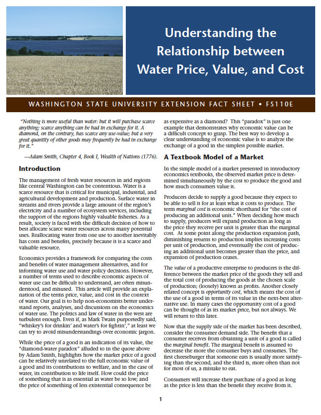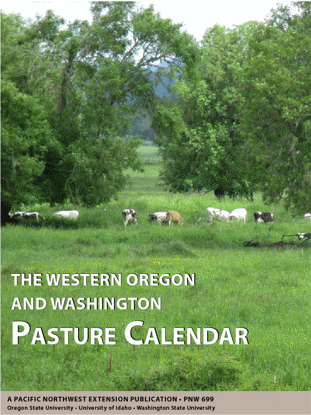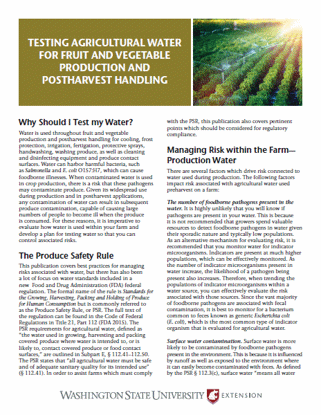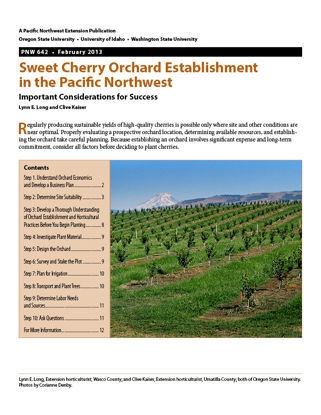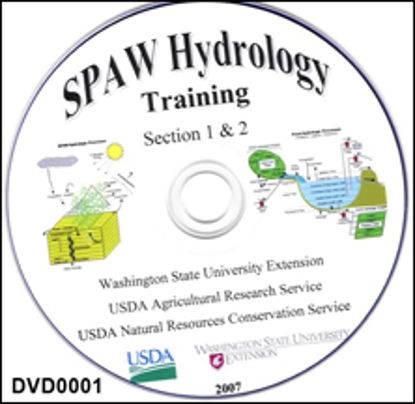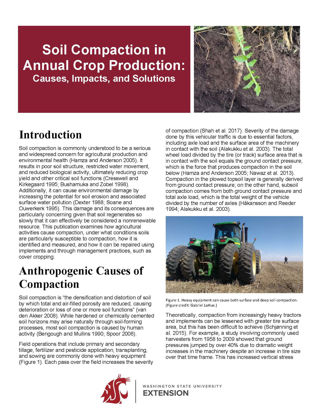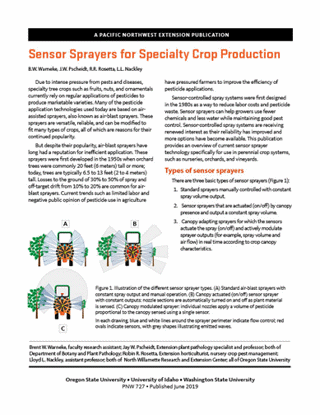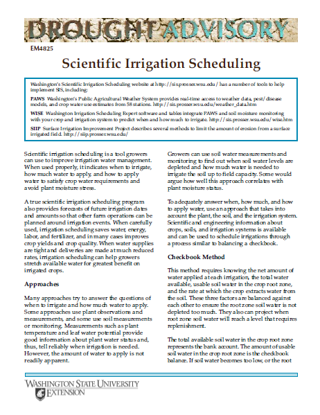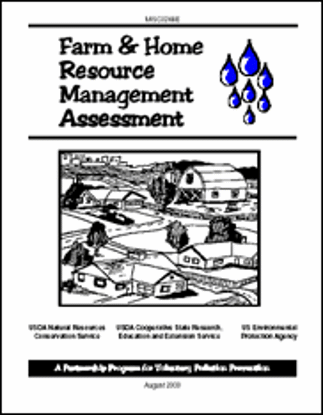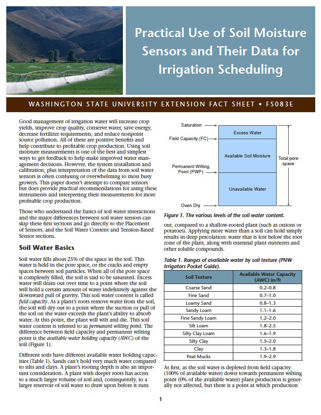You have no items in your shopping cart.
Irrigation and Water
Irrigation and Water
WSU Drought Advisory: Visual Crop Moisture Stress Symptoms
This drought advisory is a chart that lists moisture stress symptoms, critical growth periods, and other important irrigation-related factors for common Washington crops, including alfalfa, beans, cor ...
$0.00
WSU Drought Advisory: Vegetable Crops
Irrigation with sufficient water is vital to productive, profitable vegetable crops. This drought advisory describes 11 strategies for maximizing vegetable quality and profit when the water supply is ...
$0.00
WSU Drought Advisory: Sweet Corn
Sweet corn growers must watch long-term forecasts and be flexible in dry spells to manage this high moisture commodity. Explains the general needs of corn, the influence of several factors, and the re ...
$0.00
WSU Drought Advisory: Surge Flow Surface Irrigation
Surge flow irrigation is the intermittent application of water to furrows, rills, or borders in a series of on and off periods of constant or variable time spans. This drought advisory explains surge ...
$0.00
WSU Drought Advisory: Surface Irrigation Systems
Helps optimize your usable water appropriation using gravity flow. Presents the most efficient slope rates for open systems, gate and valve operation, reducing tailwater runoff, lining the ditches, an ...
$0.00
WSU Drought Advisory: Set-Move and Permanent Sprinkle Irrigation Systems
This drought advisory bulletin discusses evaluation of set-move and permanent sprinkle irrigation systems for efficiency and water conservation. Includes uniformity, pressure, nozzle inventory and wea ...
$0.00
WSU Drought Advisory: Oilseed Rape Keeps Irrigated Land Productive
This drought advisory bulletin discusses the cultivation, irrigation, and harvest needs of oilseed rape or canola as a rotation crop during drought years. Rape is a good alternative crop because most ...
$0.00
WSU Drought Advisory: Mint Irrigation Management
This drought advisory bulletin discusses the water requirements of mint. Since mint needs water all summer and has a shallow root system and low salt tolerance, growers have to focus on getting maximu ...
$0.00
WSU Drought Advisory: Managing Irrigated Pastures and Grass Hay Land
Drought-stressed hay and forage can be higher in nitrates than usual. Prevent overgrazing to protect the pasture, and test cut hay and forage for nitrate levels to protect your livestock. Authors offe ...
$0.00
WSU Drought Advisory: Irrigation System Evaluation
This drought advisory bulletin lists methods of evaluating how much water a sprinkler system can deliver in a given amount of time, to help farmers schedule irrigation scientifically for maximum use o ...
$0.00
WSU Drought Advisory: Hop Management in Water-Short Periods
Hop plants are fairly drought resistant. Author offers measures to ensure greater success under dry conditions. Discusses factors influencing some cultivars and water and fertilization patterns for di ...
$0.00
WSU Drought Advisory: Asparagus Irrigation in a Water-Short Year
The primary water absorption root zone for asparagus is down three to four feet in irrigated fields. Fill root zone early when water is short. Weed control becomes especially important in a drought ye ...
$0.00
WSU Drought Advisory: Alfalfa Irrigation with Reduced Water Supplies
Alfalfa grown for forage in the arid Northwest requires 1.8-acre feet to 3.2-acre feet of water per year, depending on length of the growing season. This drought advisory recommends steps to take in l ...
$0.00
Watering Lawns in Washington to Save Water, Save Money, and Have a Healthy, Green Lawn
If you’re finding it difficult knowing exactly how often and how much to water your lawn, this publication is for you!
$0.00
Watering Home Gardens and Landscape Plants
Making the most of available water is a challenge in times of drought. Native plants and grasses survive the best. Authors discuss the relationship of soil, water, and air for plant health. Do you rea ...
$0.00
Washington Water Rights for Agricultural Producers
In Washington State, water rights are managed by the Department of Ecology. This publication gives an overview of water rights and outlines the requirements and procedures for applying for new water r ...
$0.00
Vegetative Filter Strips as a Best Management Practice on Rill-Irrigated Row Fields
Vegetative filter strips (VFSs) are areas of land that have been planted with vegetation in order to intercept and slow down runoff water, capture eroded soil, and increase surface water infiltration. ...
$0.00
Vegetative Filter Strip Use as a Rill-Irrigated Best Management Practice
Water quality is an important aspect of irrigation, but it can be difficult to achieve. On rill-irrigated row crops, vegetative filter strips can be effective as a best management practice for improvi ...
$0.00
Using Soil Moisture Sensors in Pears
When to irrigate and how much? Fine-tuning your irrigation may be easier than you think: irrigation sensors can help answer these, and other, questions.
$0.00
Using an Atmometer for Irrigation Scheduling in Eastern Washington
Pretty simple to use and relatively inexpensive, find out how the atmometer captures local irrigation data and may help you maximize your water!
$0.00
Understanding the Relationship Between Water Price, Value, and Cost
Discussions about issues related to water in arid regions like Central Washington tend to be contentious. Tensions can be exacerbated when there is a lack of clarity over what is being discussed. This ...
$0.00
The Western Oregon and Washington Pasture Calendar
This publication describes—by climatic zone—perennial pasture plant growth and how management actions can affect growth, both positively and negatively. Optimal management of forages by season is the ...
$0.00
Testing Agricultural Water for Fruit and Vegetable Production and Postharvest Handling
Develop a plan for testing water to control and manage the associated risks: this pub tells you best practices and covers some of the associated FDA rules.
$0.00
Sweet Cherry Orchard Establishment in the Pacific Northwest: Important Considerations for Success
Regularly producing sustainable yields of high-quality cherries is possible only where site and other conditions are near optimal. This step-by-step guide summarizes factors to consider when establis ...
$0.00
SPAW Hydrology Training
This three-disk, 5-section, training DVD for the SPAW hydrology model contains five hours of instruction on the model operation, applications, interpretations, and examples. The SPAW (Soil-Plant-Ai ...
$38.50
Soil Compaction in Annual Crop Production Causes, Impacts, and Solutions
Commonly recognized as a serious concern for agricultural production and environmental health, soil compaction leads to poor soil structure, restricted water movement, and reduced biological activity. Explore the causes, impacts, and practical solutions for healthier, resilient soils.
AUTHORS: Justin Maltry, Gabe LaHue, Ani Jayakaran, Douglas Collins
$0.00
Sensor Sprayers for Specialty Crop Production
Sensor-controlled spray systems can help growers use fewer chemicals and less water while maintaining good pest control. Learn about the pros and cons of different types of sensor sprayers. ...
$0.00
Scientific Irrigation Scheduling
Scientific irrigation scheduling is a tool growers
can use to improve irrigation water management.
When used properly, it indicates when to irrigate,
how much water to apply, and how to apply
wat ...
$0.00
Protecting Your Water Quality Through a Farm and Home Assessment
This assessment has been designed to make you aware of conditions or practices on your property that increase the risk of contamination to your drinking water.
$0.00
Practical Use of Soil Moisture Sensors for Irrigation Scheduling
Good irrigation water management will increase yields, improve crop quality, conserve water, save energy, decrease fertilizer requirements, and reduce non-point source pollution. Using soil moisture ...
$0.00

